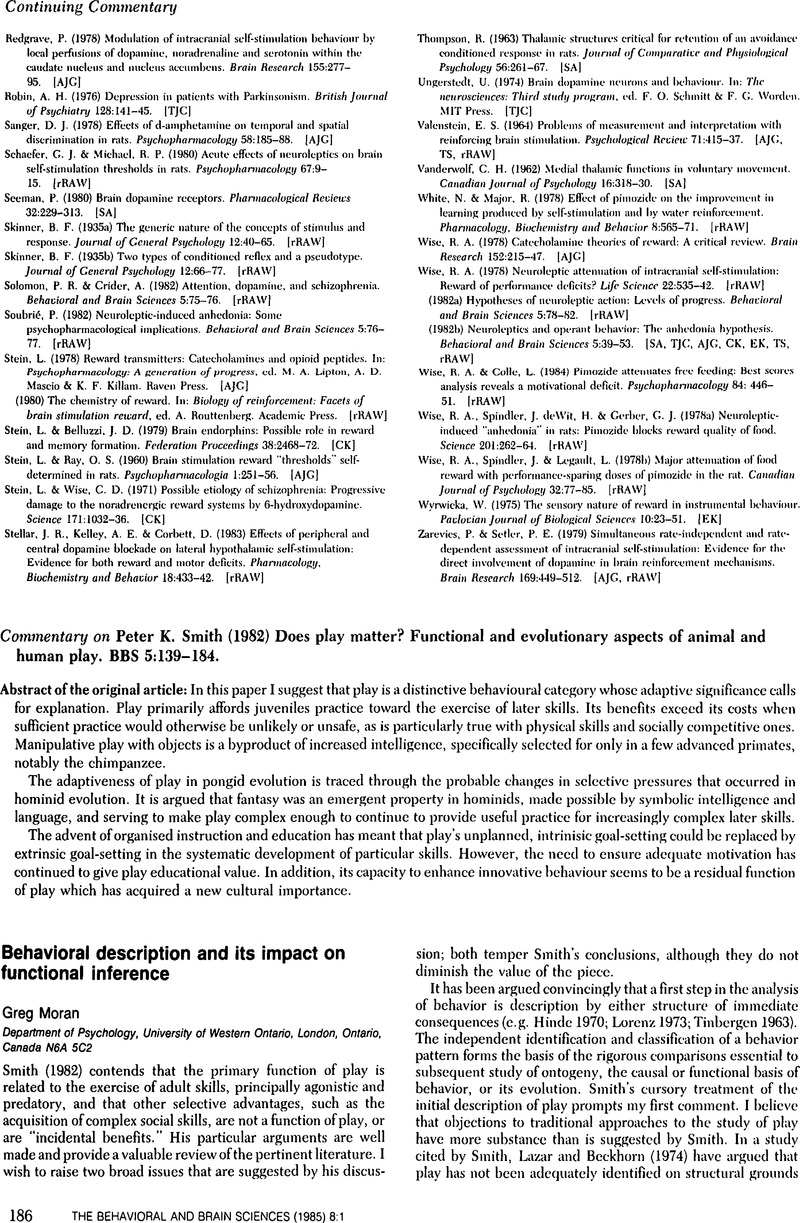No CrossRef data available.
Article contents
Functional hypotheses and their impact on behavioral description
Published online by Cambridge University Press: 04 February 2010
Abstract
An abstract is not available for this content so a preview has been provided. Please use the Get access link above for information on how to access this content.

- Type
- Author's Response
- Information
- Copyright
- Copyright © Cambridge University Press 1985
References
Bekoff, M. (1974) Social play and play-soliciting in infant canids. American Zoologist 14:323–40. [rPKS]CrossRefGoogle Scholar
Chalmers, N. (1984) Social play in monkeys: Theories and data. In: Play in animals and humans, ed. Smith, P. K.. Basil Blackwell. [rPKS]Google Scholar
Fentress, J. C. (1983) A view of ontogeny. In: Recent advances in the study of mammalian behaviour, ed. Eisenberg, J. F. & Kleiman, D. C.. American Society of Mammalogists, Special Publication no. 7. [CM]Google Scholar
Golani, I. (1976) Homeostatic motor processes in mammalian interaction: A choreography of display. In: Perspectives in ethology, vol. 1, ed. Bateson, P. P. G. & Klopfer, P. F.. Plenum. [CM]Google Scholar
Gould, S. J. & Vrba, E. S. (1982) Exaptation a missing term in the science of form. Paleobiology 8:4–15. [rPKS]CrossRefGoogle Scholar
Havkin, G. Z. (1981) Form and strategy in play behaviour between wolf pups (Canis lupus). Ph.D. thesis, Dalhousie University. [GM]Google Scholar
Hinde, R. A. (1970) Animal behaviour: A synthesis of ethology and comparative psychology. 2d ed. McGraw-Hill. [GM]Google Scholar
Hinde, R. A.(1975) The concept of function. In: Function and evolution in behaviour, ed. Bat-rands, G., Beer, C. & Manning, A.. Clarendon Press. [GM]Google Scholar
Hole, G. J. & Einon, D. F. (1984) Play in rodents. In: Play in animals and humans, ed. Smith, P. K.. Basil Blackwell. [rPKS]Google Scholar
Lazar, J. & Beckhorn, G. D. (1974) Social play or the development of social behavior in ferrets (Mustela putorius)? American Zoologist 14:405–14. [GM]CrossRefGoogle Scholar
Lorenz, K. (1973) The fashionable fallacy of dispensing with description. Naturwissenschaften 60:1–9. [CM]CrossRefGoogle Scholar
Martin, P. (1984) The (four) whys and wherefores of play in cats: a review of functional, evolutionary, developmental and causal issues. In: Play in animals and humans, ed. Smith, P. K.. Basil Blackwell. [rPKS]Google Scholar
Moran, G., Fentress, J. C. & Golani, I. (1981) A description of relational patterns of movement during “ritualized fighting” in wolves. Animal Behaviour 29:1146–64. [GM, rPKS]CrossRefGoogle Scholar
Smith, P. K. (1982) Does play matter? Functional and evolutionary aspects of animal and human play. Behavioral and Brain Sciences 5:139–84. [CM]CrossRefGoogle Scholar
Symons, D. (1978) Play and aggression: A study of rhesus monkeys. Columbia University Press. [GM, rPKS]Google Scholar
Tinbergen, N. (1963) On aims and methods in ethology. Zeitschrift für Tierpsychologie 20:410–33. [GM]CrossRefGoogle Scholar




